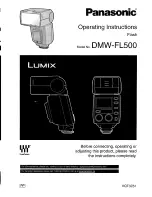
SEL50F18F (FE 1.8 / 50) (FE 50mm F1.8)
4-8
4-5-1. Optical Axis Check
1. Attach the E-mount attachment to the A-mount attachment and install them to the flange back tester.
Note:
Configure the setting of a camera attached to the E-mount attachment as follows.
• Focus Mode: Manual Focus
• Shake Compensation: OFF
2. Attach the extension jig (47.00 mm) to the objective lens (10x) to install it to the flange back tester.
3. Attach the checking lens to the flange back tester, and set the 1000 mm collimator.
1000 mm collimator
Checking lens
E-mount Attachment
Extension Jig (47.00 mm)
Camera
(General E-mount digital
single-lens reflex camera)
Fig.
4-5-3
4. Turn the focus ring to the
∞
direction so that the focus of the checking lens becomes
∞
. And adjust the optical axis while observing the microscope
until the chart image can be seen in the center.
5. Turn the focusing knob of the flange back tester while observing the microscope until the chart image comes into focus.
Also check the optical axis aligns with the chart center. (Refer to Fig. 4-5-4.)
Note:
The following figure shows example. The actual way to be seen may differ from the one in the figure.
Optical Alignment
Best alignment
Incorrect aligned
e.g. As the focusing knob is turned, the chart may appear blurry as illustrated.
The cause depends on individual lens.
Fig.
4-5-4
6. Perform Step (1) through Step (6) and ensure that the AS and CB values are within specifications.
AS
(Astigmatism):
The phenomenon where the flare on the ring chart appears in a cruciform shape with the ring chart in the sharpest focus. (Fig. 4-5-5 (a))
(1) Turn the focusing knob until the flare becomes minimum between two approximately opposite points on the ring chart edge (as shown
with the arrows in Fig. 4-5-5 (b)), and then read the dial gauge value. <A>
(2) Turn the focusing knob until the flare becomes minimum between two points with the phase of the flare rotated by 90 degrees from the
above condition (as shown with two arrows in Fig. 4-5-5 (c)), and then read the dial gauge value. <B>
(3) Calculate the AS value (absolute difference between <A> and <B>) and ensure that it is within the specification.
AS value = <A> - <B>
CB (Center Blur):
The phenomenon where the flare on the ring chart trails in one direction with the ring chart in the sharpest focus. (Fig. 4-5-5 (d))
(4) Turn the focusing knob until the ring chart edge in the direction of the maximum flare is in the sharpest focus (as shown with the arrow in
Fig. 4-5-5 (e)), and then read the dial gauge value. <C>
(5) Turn the focusing knob until the ring chart edge, opposite 180 degrees from the above condition (as shown with the arrow in Fig. 4-5-5
(f)) is in focus, and then read the dial gauge value. <D>
(6) Calculate the CB value (absolute difference between <C> and <D>) and ensure that it is within the specification.
CB value = <C> - <D>
(1)
(1)
(2)
(2)
(5)
(4)
AS
E
D
F
H
G
I
CB
Fig.
4-5-5
Specification (Reference)
CB (Center Blur)
0.07 mm or less
AS (Astigmatism)
0.05 mm or less
Table
4-5-1
7. If the specifications of CB and AS are not satisfied, replace the F Group Service Assy.
















































